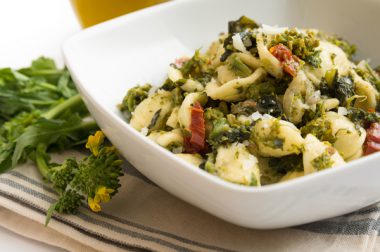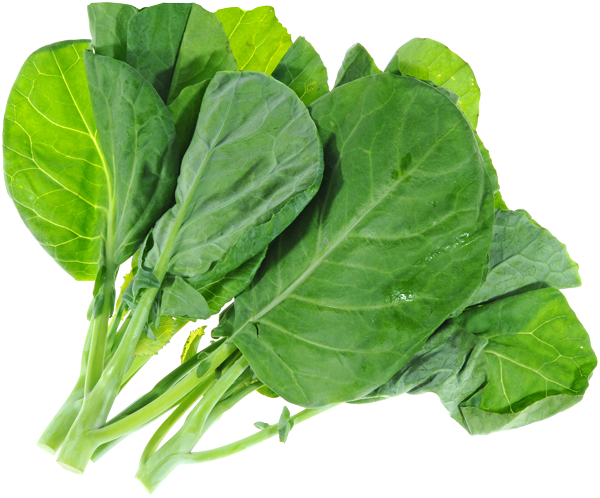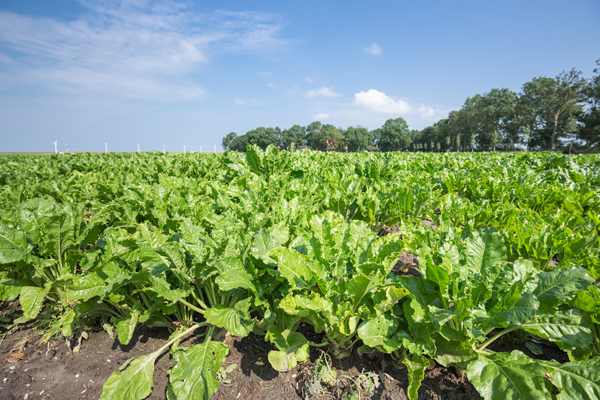Recipes we love
See all recipesRice with rapini
Even the most vegetable-averse can be won over when offered cooked vegetables mixed with rice. Seaso...
Health
benefits
Packed with provitamin A !
A serving of bitter greens is enough to cover your daily value of provitamin A and beta-carotene! The body transforms the latter into vitamin A. Vitamin A plays a role in iron metabolism, skin and mucous membrane health, eyesight, immunity, and growth.
Bitter greens are also :
- a source of iron (for cognitive function, red blood cells, the immune system, energy, and fatigue reduction)
- a source of magnesium (for fatigue reduction, energy, protein synthesis, muscular contraction, nerve impulse transmission, and bone and teeth health)
- a source of fiber (for bowel movement regulation, satiety)
They also contain :
- vitamin C
- potassium
- calcium
Nutritional
composition
When is the right
time to eat them?
All year.
Bitter greens are available year-round but are more abundant between fall and spring.
Vegetable patch
or urban balcony?
Bitter greens include young shoots of broccoli rabe, turnips, and cabbage. These three grow well in well-drained, neutral (pH = 7) soil rich in humus, in full sun.
To learn everything you need to know about growing bitter greens, read the page on growing advice.
Choosing and
storing bitter greens
Choose your bitter greens well:
- The leaves must be dark green, very uniform, smooth, shiny, and without spots.
Properly store your bitter greens:
- Like all leafy vegetables, bitter greens last two to four days in the vegetable drawer of the refrigerator.
Tips and
tricks
How to prepare bitter greens
Wash the leaves and cut off the bottom of the stems if they are too hard.
Since these fresh leaves are so bitter, they need to be cooked, whether sautéed or boiled.
Bitter greens go well with…
Italian, Portuguese, and Spanish (Galician) cuisines all make frequent use of cooked bitter greens. In Spain, they are eaten in lacón con grelos along with pork and chorizo, with shrimp omelets, or in creamy soups. In Italy, they are paired with pasta (for example, in orecchiette alle cime de rapa). In Portugal, they are eaten in traditional dishes such as caldo galego, a soup, and lacón con grelos.
Can everyone
eat them?

Young children
Children can begin eating bitter greens, prepared like spinach, starting at 6 months. However, children may not like their bitterness and may find them easier to eat pureed with potatoes.
And everyone else…
Everyone can enjoy bitter greens, especially those who like bitter flavors.
See plenty of other tips for encouraging children to eat vegetables
Where do they come from?
Origins and varieties
Origins: The Galicians (from northwestern Spain) are major producers and consumers of bitter greens. In Italy, broccoli rabe shoots are particularly featured in southern cuisine (from the province of Bari).
Varieties: In French and Spanish, “grelos” literally means “buds.” The word designates certain bitter greens such as broccoli rabe shoots (Brassica ruvo), which are harvested before flowering and taste like a more bitter version of broccoli. Grelos also include turnip tops and the last leaves harvested just before flowering (called grelos de nabos in Spanish or cime di rapa in Italian), as well as cabbage leaves harvested before the plant flowers (grelos de couve in Spanish). Grelos have pointy leaves that surround a green bud that resembles a head of broccoli. They have a somewhat nutty flavor, bitter and spicy.
Chinese cabbage is lighter green in color and is not bitter or spicy at all. Its bud opens into small, yellow, edible flowers. This vegetable probably comes from a wild herb related to turnips that developed in China or the Mediterranean region. It can now be found throughout the entire world.



 Celery
Celery  Chard
Chard  Crop Rotation
Crop Rotation 










